AI Influencer Analytics Trends Shaping the Future of Marketing
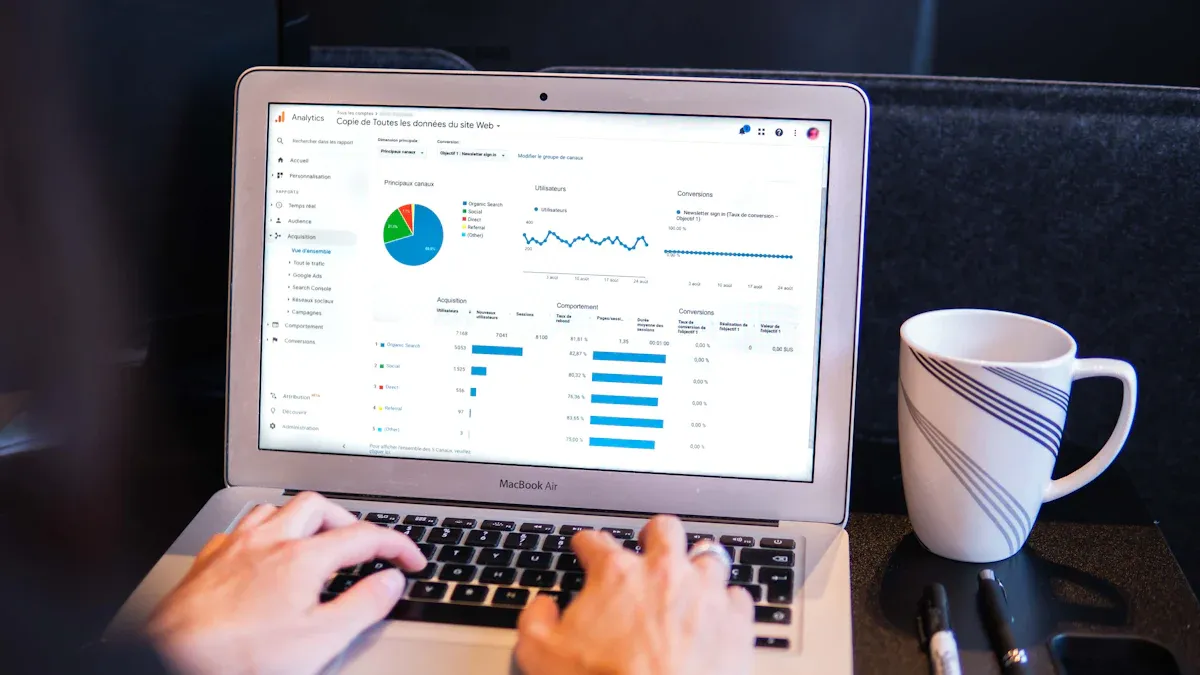
AI influencer analytics is changing influencer marketing in 2025. Brands now have a lot of competition. 86% of US marketers work with influencers. 26% spend over 40% of their marketing money on influencer marketing. This helps make the industry worth $24 billion.
Statistic Description | Value/Trend |
|---|---|
US marketers partnering with influencers in 2025 | 86% |
Agencies/brands allocating >40% budget to influencer marketing | 26% |
Influencer marketing industry valuation in 2024 | $24 billion |
AI trends like predictive analytics, hyper-personalization, and real-time campaign optimization are causing these changes. New ai-powered influencer marketing tools like Lillian help everyone use advanced analytics and campaign optimization, not just big companies. Marketers using ai tools can find the best influencer, guess how campaigns will do, and get the most from their money. Learning new influencer marketing trends will help brands stay ahead in 2025.
Key Takeaways
AI influencer analytics helps brands find top influencers quickly. It also helps improve campaign results by using live data and smart tools.
Micro and nano-influencers get more engagement and cost less. They help build trust and reach the right people.
Virtual AI-generated influencers make brands more creative and fun. They connect well with young people and are always available.
Real-time tracking and smart analytics help marketers fix campaigns fast. This helps them get more value and waste less money.
Marketers should use both AI insights and human ideas. They need to focus on being real and watch campaigns often to do well in influencer marketing.
AI Influencer Analytics in 2025
What It Means for Influencer Marketing
In 2025, ai influencer analytics is very important. Brands use ai to find the right people faster. Almost 70% of marketers use ai to pick their audience. This change helps brands split groups better and run stronger campaigns. Ai makes targeting more exact, up to 85% better. Influencer marketing trends show brands want quick data and clear results. Ai lets marketers see how campaigns do right away and change plans fast.
Influencer marketing in 2025 is about being quick and real. Ai does tasks for 40.1% of workers, so they save time. Marketers use ai to pick influencers who fit their brand. They also use analytics to check engagement and money earned. Ai-driven influencer marketing helps brands grow and reach many people. For example, the Heinz ai campaign reached over 850 million people and got 38% more engagement.
Brands using ai influencer analytics get ahead. They can make content special, build strong groups, and get better results.
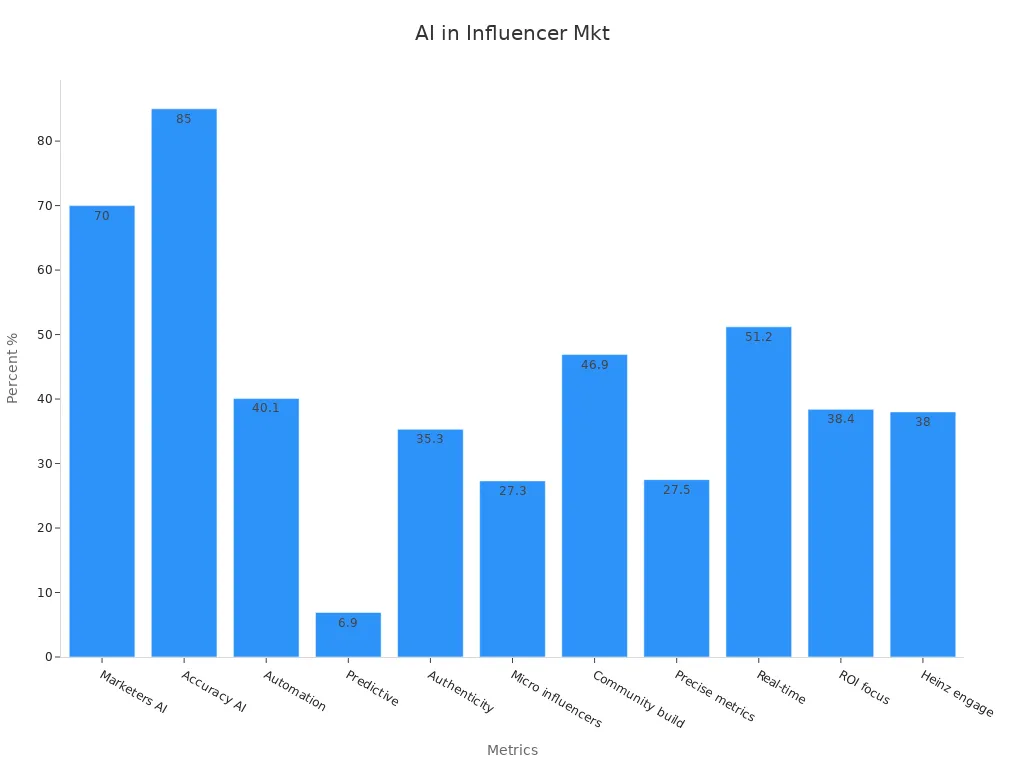
Key Shifts and Trends
Some big trends shape influencer marketing in 2025. Ai trends help more brands use micro-influencers, with 27.3% picking them for small groups. Building a community is important, with 46.9% using ai analytics to help people connect. Real-time tracking is normal now, with 51.2% of workers using it. Ai helps brands check ROI better, and some campaigns get up to 11x return.
Campaigns with ai influencer analytics get more brand awareness and loyalty.
Marketers work 40-60% faster and spend less money.
Influencer marketing trends in 2025 show brands need good data, realness, and ways to grow. Brands that follow these trends lead in marketing today.
Influencer Discovery Trends
AI Matching and Selection
AI is changing how brands find influencers. It makes the process faster and more exact. Brands use ai tools like Lillian to look at many social media profiles in seconds. Lillian’s triple ai engine helps brands match with influencers who share their values. This takes away guessing and helps brands pick the best influencer for each campaign.
Sprout Social and other tools mix databases, content results, and audience details. These features help brands see trends and find top creators early. Lillian’s real-time checks and prediction tools show which influencer partnerships will do well. Brands can change campaigns fast using live feedback and engagement numbers.
Tip: Small teams can use cheap ai tools like Lillian to keep up with big brands. These tools give deep analytics, spot fake followers, and help improve campaigns for less money.
AI matching tools give strong results:
Look through lots of data to find the best influencer.
Guess how well a campaign will do with predictive analytics.
Watch engagement numbers that help make money.
Check ROI and audience feelings as they happen.
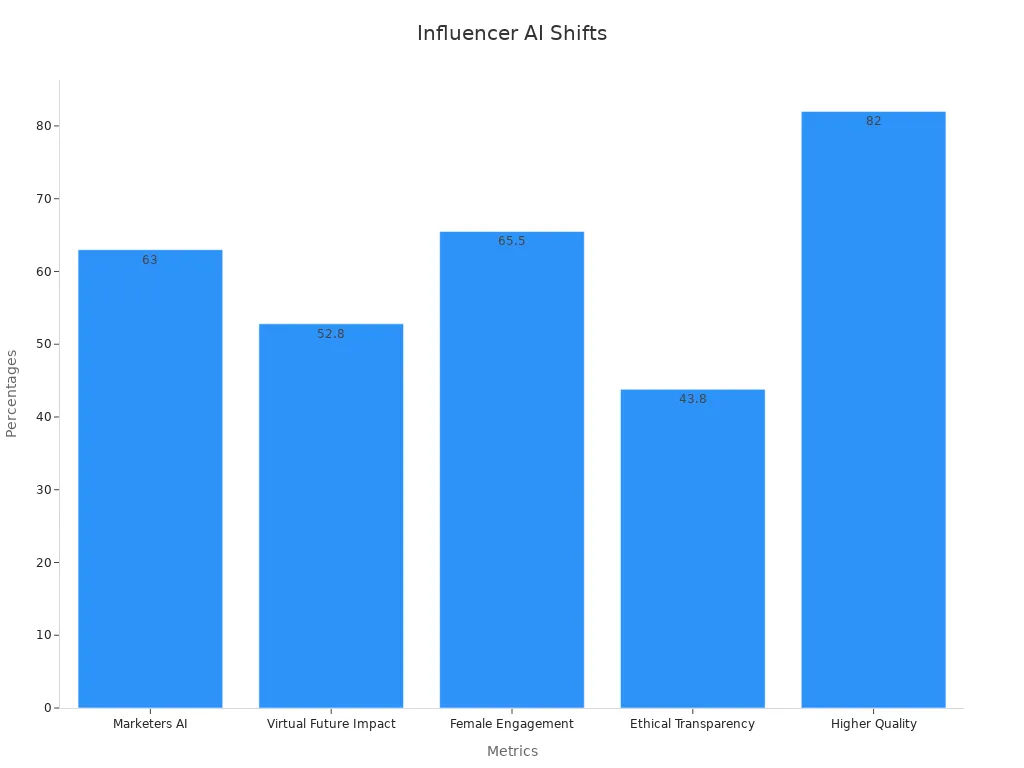
Micro and Nano-Influencers
Micro and nano-influencers are shaping influencer marketing’s future. They have smaller but very active audiences. Brands get higher engagement rates with micro influencers, especially on TikTok and Instagram. For example, nano-influencers get 10.3% engagement on TikTok, much more than mega-influencers.
Statistic Aspect | Data / Percentage | Explanation |
|---|---|---|
Engagement Rate on Instagram | 2.19% | Nano-influencers have higher engagement than mega-influencers. |
Engagement Rate on TikTok | 10.3% | Shows superior campaign effectiveness. |
Platform Presence | 88% on TikTok, 77% on Instagram | Most influencers on these platforms are nano-influencers. |
Cost per Post | $10 - $100 | Nano-influencers offer cost-effective options. |
Brand Collaboration Growth | 33% annual increase | Demand for micro and nano-influencers is rising. |
Brands Working with Nano-Influencers | 76% of brands | Widespread adoption in campaigns. |
Consumer Purchase Influence | 63% of consumers | Most people trust recommendations from influencers. |
Use for User-Generated Content | 56% of businesses | Brands value authentic content from micro influencers. |
Industry Growth Projection | $48 billion by 2027 | The industry is expanding rapidly. |
Micro and nano-influencers help brands reach small groups and build trust. Lillian’s ai engine finds these influencers fast, even for brands with little money. Brands can run more campaigns, try new ideas, and get better results without spending a lot. Micro influencers also make real content that gets true engagement and sales.
Note: Brands should try to build long-term partnerships with micro and nano-influencers. This helps grow loyalty and gives better ROI in influencer marketing.
Virtual Influencers and AI Content
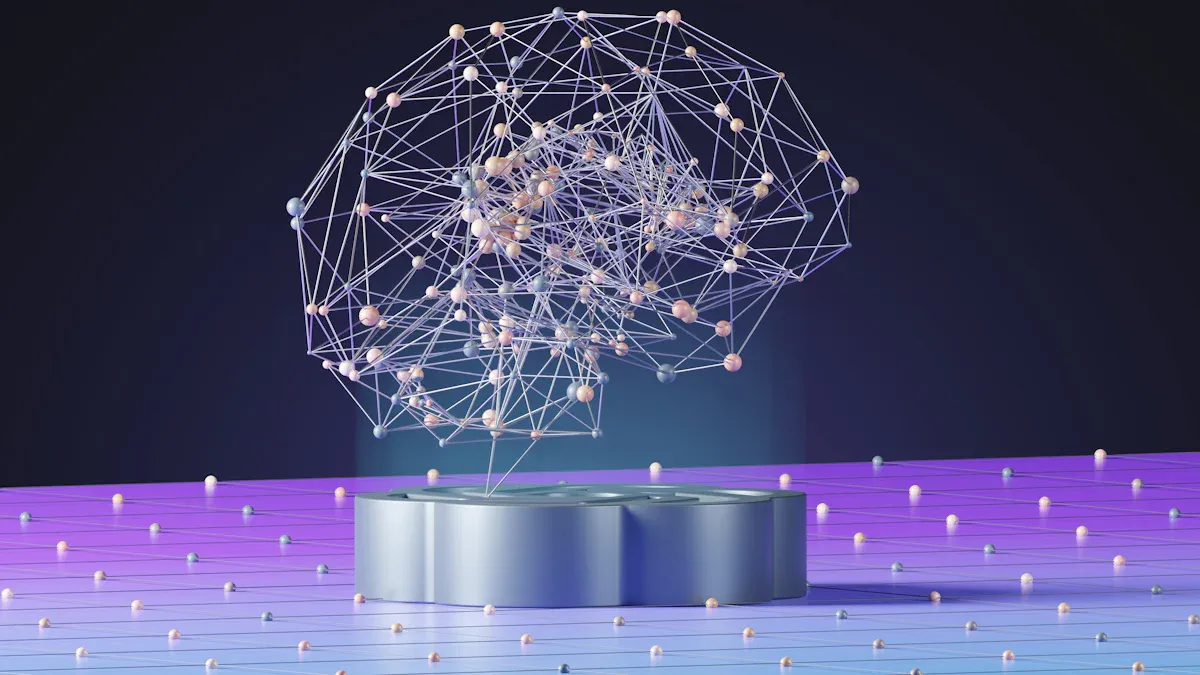
Rise of AI-Generated Influencers
Brands use ai-generated influencers to talk to new people. These digital personalities are made with ai and CGI. They give brands special advantages:
Companies spend less money by using ai-generated influencers.
Brands can decide exactly how the influencer looks and acts.
Virtual influencers are online all day, so fans can see them anytime.
New ai tools make these influencers look more real and interesting.
North America and Europe make most of the money in this market.
Asia-Pacific is growing quickly because more people use social media.
Most fans are 18 to 35 years old, mostly in richer countries.
The pandemic made virtual influencers more popular at online events.
Luxury, fashion, and retail brands like Prada and Balenciaga use ai influencers to show off products. These brands get more creative ideas and more control. In places like Brazil and South Korea, virtual influencers are very popular.
Metric/Aspect | Details |
|---|---|
Market Size (2023) | |
Projected Market Size (2032) | USD 154.6 Billion |
CAGR (2024-2032) | 41.29% |
Leading Market Segment | Human avatar virtual influencers (66% revenue share in 2023) |
Dominant Industry Segment | Fashion & lifestyle (largest revenue share in 2023) |
Regional Market Share (2023) | North America (41%) |
Regional Growth | Asia-Pacific expected fastest CAGR due to social media acceptance and promotional demand |
Brand Adoption Examples | Prada, Balenciaga, Samsung, LVMH |
Adoption Drivers | Cost-effectiveness, brand control, 24/7 availability, enhanced consumer engagement |
Impact on Engagement
Ai-generated influencers have changed how brands talk to people. The ai influencer market is growing fast. It reached $6.06 billion in 2024 and grows over 40% each year. Brands can start campaigns faster because ai saves time. Ai tools help brands spot fake followers and match with the right audience.
Engagement rates show how strong virtual influencers are. On Instagram, they get up to 3% more engagement. Their average engagement rate is 2.84%. This is higher than human influencers at 1.72%. In 2023, virtual influencer campaigns got 5.9% engagement, three times more than real influencers. Women like virtual influencer posts 65.5% of the time. Gen Z and Millennials, especially ages 13-17, really like them. 81% of Gen Z follow influencers.
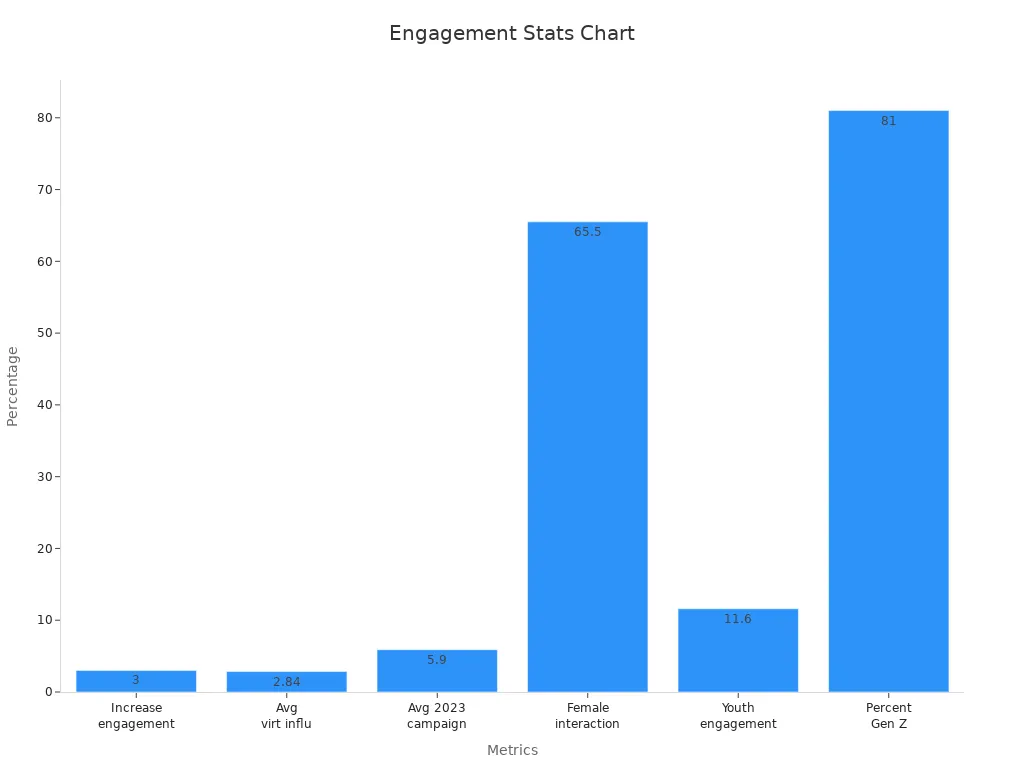
Ai-generated influencers help brands find new fans, get more likes, and build trust with young people. As ai gets better, brands will see even more success with these digital campaigns.
Predictive Analytics and ROI
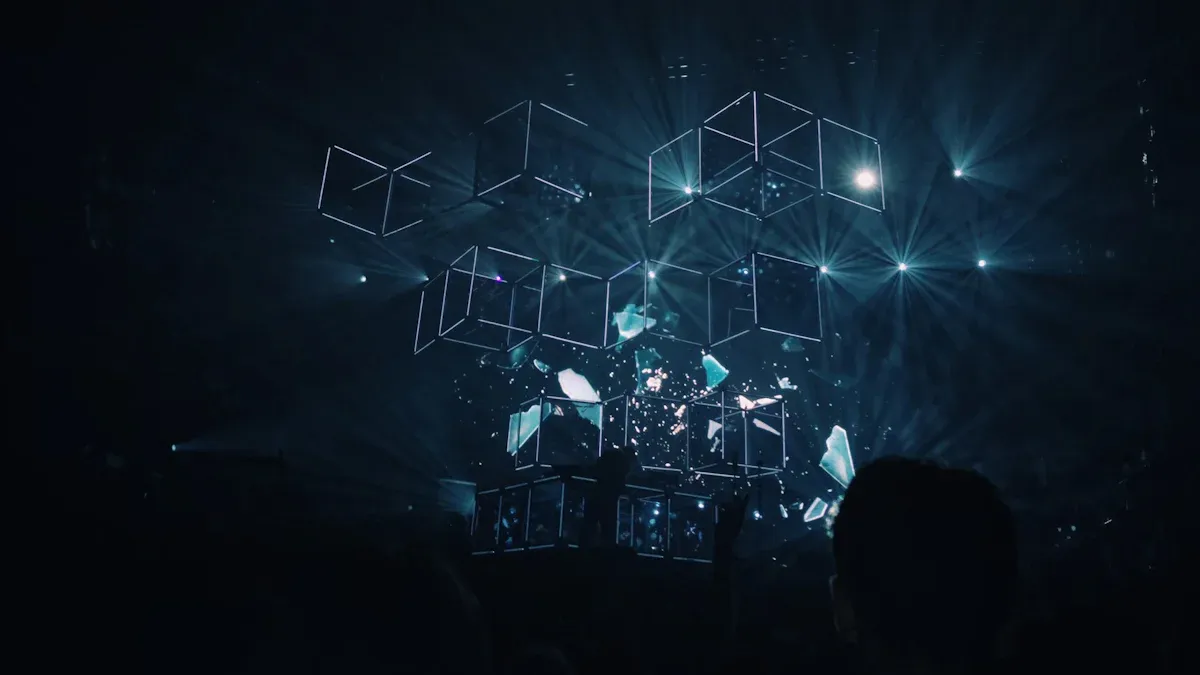
Real-Time Performance
In 2025, brands use ai to watch influencer campaigns as they happen. Real-time numbers show what works and what does not. These numbers include clicks, actions, money earned, engagement, conversions, reach, and impressions. They also count how many influencers are active. Tools like Lillian give live updates on these numbers. Marketers use dashboards to see trends and make fast choices. If one influencer gets more clicks, brands can move money to them right away.
Tip: Brands should check engagement and conversion rates during every campaign. This helps them find the best influencers and use their money well.
Here are some tools and numbers for real-time tracking:
Dashboards to see trends
Calculators for engagement rates
Tools to check audience details
ROI calculators
Content tools with UTM tracking
Forecasting Campaign Success
Ai-powered predictive analytics help brands plan influencer campaigns with more trust. Lillian’s prediction models use old campaign data to guess ROI, engagement, and conversions. These models look at audience details, engagement patterns, and brand fit. They also find fake followers and bots, so brands work with real people.
Brands get good results with predictive analytics. For example, a makeup brand used ai to move money to top influencers and got a 7.2x return. A tech brand chose mid-level YouTube influencers and saw sales go up 6.8 times from referrals. The table below shows more results from predictive analytics in influencer marketing:
Aspect / Case Study | Figures / Results | Explanation |
|---|---|---|
Holistic ROI Calculation Example | Combines sales, follower growth, and content value against investment. | |
Hurom ROAS Increase | 2.5x ROAS | Targeted influencer strategies with precise tracking. |
Body & Fit Average RoAS | AI-driven tracking and budget optimization. | |
Top Creators RoAS | Up to 12:1 | Highest performing influencers in the campaign. |
Genomelink CAC Reduction | 73% reduction | Nano-influencers lowered customer acquisition costs. |
Note: Brands should use ai to try different influencer strategies. Predictive analytics help them focus on what works and not waste money.
Cross-Platform Analytics
Unified Data Insights
Cross-platform analytics helps brands see all their social media work. Unified data analytics puts information from many places together. This includes both organized and messy data. This way, brands do not miss important trends. When data is in one spot, brands keep all their insights safe. They can follow the whole customer journey on every platform.
Unified dashboards and user ID tracking let brands watch users move between websites and apps. These tools show which platforms get the most sales. Marketers know where to spend their time and money. Central dashboards help spot fake likes and track real results. Automated reports and AI insights keep data correct and useful. Brands use these facts to target better, make content special, and get more engagement everywhere.
Tip: Brands should use insights they can act on, not just collect data. This helps them make smart and quick choices for social media.
Overcoming Fragmentation
Many brands have trouble with data split across different channels. Each platform often keeps its own data, making things confusing. Marketers use tools that gather all data into one place. This helps teams see what works and make fast choices.
Marketing and IT teams must work together. By teaming up, they connect data and make things easier. SaaS platforms with good connections and rules help too. Using the same names and checking data keeps it right. Cross-channel models, like first-touch or time-decay, show how each step helps a campaign. This way, brands can plan better and get more from their ads, especially with ai.
Note: Sharing data between teams builds trust and makes analytics better. This change helps brands get more out of social media.
Authenticity and Ethics
Fraud Detection
Brands have many problems in influencer marketing. Finding fraud is one of the biggest. Influencer fraud can hurt trust and waste money. AI and machine learning help brands find fake influencers fast. These tools check follower quality, engagement, and audience overlap. If scores are low or engagement drops, it could mean fraud. AI tools look at thousands of profiles in seconds. This is much faster than people checking by hand. These systems keep learning and get better at spotting new tricks.
Techniques and Algorithms | |
|---|---|
Anomaly Detection | Unsupervised learning (k-means, DBSCAN), density-based (Local Outlier Factor), Gaussian Mixture Models, PCA, Isolation Forests, Autoencoders |
Predictive Modeling | Supervised learning (logistic regression, decision trees, random forests, gradient boosting), deep learning (CNNs, RNNs), ensemble methods (Random Forests, XGBoost) |
Network Analysis | Link analysis, social network analysis, graph-based methods (PageRank, community detection, graph embeddings) |
Brands use these ways to make sure engagement is real. This helps protect their campaigns. By picking real influencers, brands build trust and get better results.
Transparency in Influencer Marketing
Being open builds trust in influencer marketing. Influencers must say when posts are sponsored. Hashtags like #ad or #sponsored help people know about paid posts. Brands and influencers who follow these rules get more trust. They do not hide the truth or use clickbait.
Explanation | |
|---|---|
Transparency and Disclosure | Full and clear disclosure of sponsored content to maintain audience trust and comply with laws. |
Authenticity | Maintain genuine content aligned with core values, avoiding overly curated or manipulated personas. |
Accountability Measures | Implement guidelines, training, audits, and feedback mechanisms to ensure ethical compliance. |
Long partnerships between brands and influencers help keep things real. When influencers control their content, it feels more honest. User-generated content also makes campaigns more believable. People trust user content because it shows real life. Brands that care about culture, privacy, and copyright show good ethics. These steps help influencer marketing stand out as real and trustworthy.
Tip: Brands should check engagement using things like audience feelings and brand love. This keeps influencer marketing honest and strong.
Workflow Automation Trends
AI Agents and Efficiency
AI agents help make influencer marketing much faster. These tools do jobs like sorting groups, checking campaigns, and looking at data. Teams use ai agents to do boring tasks. This lets marketers spend more time on ideas and talking to people. AI helps save time in many ways:
Teams can run more campaigns and work with more influencers.
AI finds fake followers by checking follower quality.
Smart filters help find influencers by group size and age.
Dashboards update by themselves, so no one has to add up numbers.
Marketing agencies finish campaigns much faster now. The table below shows how ai cuts down the hours needed for each step:
Workflow Stage | Traditional Time (hours) | AI-Enhanced Time (hours) | Improvement Description |
|---|---|---|---|
Campaign Development | 264 | 88 | 67% reduction in total campaign development time through ai-powered automation and data-driven insights. |
Client Approval | 20 | 5 | Streamlined approval cycles via real-time collaboration and automated revision tracking. |
Campaign Execution | 40 | 15 | Automated cross-platform deployment and real-time optimization reduce execution time significantly. |
Client Briefings | 24 | 8 | Automated data analysis and market trend identification speed up briefing preparation. |
Strategy Development | 40 | 15 | Predictive modeling and automated audience segmentation enable faster, data-driven strategy creation. |
Performance Analysis | 30 | 10 | Shift from post-campaign reporting to continuous real-time monitoring with predictive insights. |
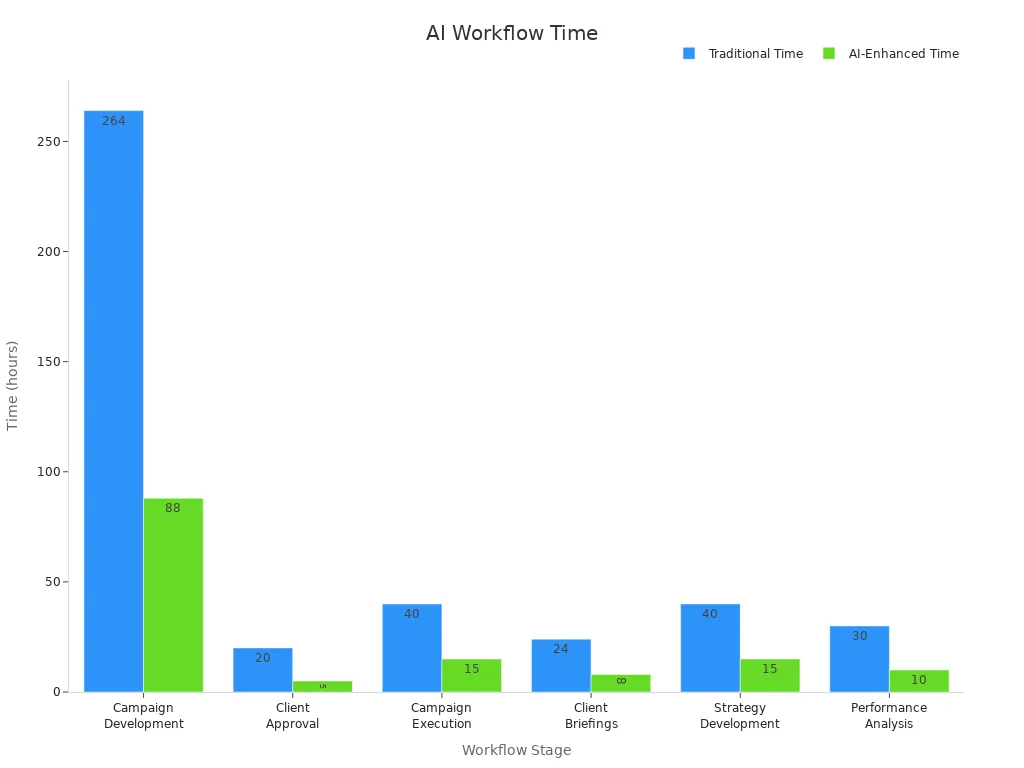
AI agents let teams do many things at once. They can watch how campaigns do and make changes right away. These trends show that ai saves time and helps teams do better work.
Creative Strategy Focus
Automation lets creative teams spend more time on new ideas. AI takes away boring jobs, so marketers can think of cool campaigns. Some important numbers show this change:
Performance Indicator | Description and Impact on Creative Strategy Formulation |
|---|---|
Time-to-Publish | Automation reduces manual tasks, speeding up content delivery and enabling faster iteration of creative ideas. |
Error Reduction Rates | Automated workflows minimize human errors, improving quality and reliability of creative outputs. |
Content Reuse Efficiency | Automation facilitates repurposing existing content, freeing creative teams to focus on strategy rather than repetitive creation. |
Team Productivity Benchmarks | By automating routine tasks, teams can allocate more time to strategic and creative work, enhancing overall productivity. |
Real-Time Data Synchronization | Centralized, automated data updates provide marketers with timely insights to optimize campaigns and creative strategies dynamically. |
AI helps teams see new data right away. Marketers can change their ideas fast if something is not working. Teams use ai to test posts, see what people like, and fix messages quickly. These trends help brands keep up and do well online.
Personalization and Engagement
Hyper-Personalization at Scale
Brands use hyper-personalization to reach people more accurately on social media. Influencer campaigns use data to suggest content that matches what users like. Companies such as Gannett and Mediahuis saw engagement go up by 60% and 23% with active personalization.
Company | Personalization Strategy | Engagement Increase |
|---|---|---|
Gannett | Active personalization efforts | 60% |
Mediahuis | Active personalization efforts | 23% |
Many top brands use personalization to get better results: 1. The New York Times sends special email newsletters, which helps keep readers and get more subscribers. 2. BuzzFeed changes its content style using audience data, so more people share their posts. 3. Spotify makes playlists based on what people listen to, which keeps users coming back. 4. Netflix suggests shows using what people watch, so more people stay subscribed.
Hyper-personalization helps brands make 10-15% more money. Almost 75% of people will not buy if things are not personalized. Marketers get more sales and spend less to get new customers. These ways help influencers connect with followers and build trust.
Real-Time Audience Interaction
Real-time interaction lets influencers talk to people right away on social media. Marketers watch numbers like page views, bounce rate, average time on page, and social shares to see what works.
Metric | Description |
|---|---|
Page Views | Counts how often a page is viewed |
Bounce Rate | Shows the percentage of visitors who leave after one page |
Average Time on Page | Reflects how long users stay on a page |
Social Shares | Tracks how often content is shared |
Influencers look at likes, comments, shares, video views, and click-through rates to know what people enjoy. UGC and influencer-led campaigns get instant feedback, so brands can change content fast. Real-time checks help marketers make campaigns better and connect more with people. UGC and social media engagement help brands grow and keep campaigns real.
Best Practices for 2025
Action Steps for Marketers
Marketers in 2025 work in a world that changes fast. Influencer marketing now uses lots of data and smart tools. Brands that want to win need AI influencer analytics for every campaign step. Here are the best ways to do well:
Invest in AI-Powered Platforms
Marketers should pick tools that help with finding influencers, checking data, and stopping fraud. Platforms like Lillian help brands find good creators, check audience quality, and see results right away.Prioritize Authenticity Over Follower Counts
AI analytics help marketers see if followers really care, not just count them. Brands should choose influencers who talk with their fans. This builds trust and makes partnerships stronger.Combine AI Insights with Human Judgment
AI can show which influencers might work best. But people know their brand’s style. Teams should use AI data and their own ideas to pick influencers who fit the brand.Experiment with Virtual Influencers
Virtual influencers give brands new ways to reach people. Marketers can run creative campaigns that are always active and different from others.Continuously Monitor and Optimize Campaigns
AI analytics let marketers watch how things go as they happen. Teams should change posts, times, and budgets using live data. A/B testing with AI helps make messages better for the right people.Automate Workflows with AI Agents
Marketers can save time by letting AI do jobs like writing briefs, checking rules, and tracking results. This lets teams spend more time on ideas and building relationships.Leverage AI for Competitive Analysis
Brands should use AI to watch what others do and spot new trends. This helps them find ways to do better than their rivals.Integrate Influencer Data with Other Marketing Channels
Marketers should link influencer data with loyalty programs and sales numbers. This shows how influencer marketing helps the brand grow over time.
Real-world results show brands using these steps get up to 20% more conversions and 30% better marketing results. For example, a beauty brand used AI to find micro-influencers for a clean beauty campaign. They got 40% more engagement and 25% more conversions.
Brand | Measurable Outcome | Description |
|---|---|---|
Unilever | Built a new way to measure influencers and spent money smarter. | |
Sephora | Integration of influencer data with loyalty program | Learned how influencer customers help the brand over time. |
Adidas | Attribution model linking influencer content to offline purchases | Showed how online influencer posts led to in-store sales. |
Marketers who follow these steps can build better influencer partnerships, use money wisely, and show how influencer marketing helps their business.
Common Mistakes to Avoid
Even with good tools, marketers can make mistakes in influencer marketing. Small teams and businesses should watch out for these common problems in 2025.
Relying Only on Vanity Metrics
Many marketers still look at follower counts or likes. These numbers do not show real engagement or sales. Teams should use AI analytics to check real results, like conversions and loyal customers.Ignoring Micro-Influencers
Some brands forget about micro and nano-influencers. These creators often get more engagement and cost less. Picking them can make influencer marketing more real and give better returns.Failing to Monitor for Fraud
Influencer fraud is still a problem. Brands that skip AI fraud checks may waste money on fake followers or bots. Marketers should always check audience quality and engagement.Not Integrating Data Across Channels
Keeping influencer data separate from other marketing makes it hard to see the big picture. Brands should connect influencer analytics with sales, loyalty, and offline data.Over-Automating Without Human Oversight
AI can do many jobs, but it cannot replace human ideas. Marketers should use AI to help, not to take over their work.Neglecting Compliance and Transparency
Brands must make sure all influencer deals follow the rules. AI can help check for this, but teams should also teach influencers about disclosure.
Tip: Marketers should check campaign data often and change plans quickly. This helps avoid wasting money and keeps influencer marketing working for business goals.
Lack of Continuous Optimization
Some teams set up campaigns and then forget about them. In 2025, influencer marketing needs constant checks and updates. Brands that do not keep up miss new trends and chances.Short-Term Thinking
Building long-term influencer partnerships works better than one-time deals. Marketers should focus on relationships, not just quick wins.
By avoiding these mistakes, marketers can get the most from AI influencer analytics. They can get more engagement, stronger brand loyalty, and better results from influencer marketing in 2025.
In 2025, influencer marketing will use AI analytics more. Marketers get better results on social media with these tools. They see stronger campaigns, spot fraud faster, and get more engagement. More than 48% of brands already use AI for influencer marketing. About 63% want to use it even more soon. Real-time data lets teams change campaigns for better ROI. Brands should try platforms like Lillian to do well online. Learning new things and changing plans will help brands stay strong as trends change in 2025.
FAQ
What is AI influencer analytics?
AI influencer analytics uses artificial intelligence to look at influencer data. It helps brands pick the right creators for their campaigns. Brands can see how well their campaigns do and spot fake likes or comments. This technology makes influencer marketing faster and smarter. It also helps brands get better results.
How does Lillian help small brands with influencer marketing?
Lillian gives small brands tools to study data and match with influencers. The platform uses AI to quickly find the best creators for each brand. This helps brands save time and money. They can reach more people and get better results from their campaigns.
Can AI detect fake followers and engagement?
Yes. AI tools like Lillian check influencer profiles for fake followers and strange activity. These systems look at how people interact with posts and if the audience is real. Brands use this information to avoid fraud and make sure their campaigns work.
Why are micro and nano-influencers important in 2025?
Micro and nano-influencers have fans who really care about their posts. Brands work with them to reach special groups and build trust. These partnerships usually cost less and give better results than working with big influencers.
See Also
Best Platforms For Influencer Analytics To Use In 2025
2025 Influencer Marketing ROI Trends Driving Business Growth
Essential Metrics For Measuring Influencer Marketing ROI 2025
Effective Strategies To Boost Influencer Marketing ROI In 2025
Simplified Methods For Tracking Influencer Marketing ROI 2025
